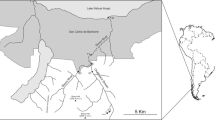Abstract
Lake Balaton, the largest shallow lake in Central Europe, is about 20 000 years old. An enormous increase in tourism and the disproportionate building development of the last few decades has resulted in the acceleration of eutrophication in the lake. Widespread research to reveal the causes of water-quality deterioration and possible ways of protection against it have recently started. The investigation of the larvae of non-biting midges (Diptera: Chironomidae) in the sediment of the open-water zone has also begun. The contemporary faunal composition strongly correlates with the trophic gradient along the longitudinal axis of the lake. We therefore supposed that the eutrophication process should be identifiable from the analysis of subfossil chironomid head capsules from the upper (15 cm thick) layer of the sediment. We found that quantitative results could only be obtained when fragments as well as relatively intact head capsules are considered. Our data verify that the originally oligo-mesotrophic community has been gradually replaced by eutrophic species in a west to east direction. Large-bodied larvae belonging to the Chironomus plumosus group mix the sediment down to 15 cm as they build their tubes and consequently alter the original proportions of head capsules at the different levels. So the sequence of communities through the sediment-layers is not quite reliable.
Similar content being viewed by others
References
Biró, P., 1977. Effects of exploitation, introductions and eutrophication on percids in Lake Balaton. J. Fish. Res. Bd Can. 34: 1678–1683.
Brundin, L., 1958. The bottom faunistical lake type system and its application to the southern hemisphere. Moreover a theory of glacial erosion as a factor of productivity in lakes and oceans. Verh. int. Ver. Limnol. 13: 288–297.
Carter, C. E., 1976. A population study of the Chironomidae (Diptera) of Lough Neagh. Oikos 27: 346–354.
Carter, C. E., 1977. The recent history of the chironomid fauna of Lough Neagh, from the analysis of remains in sediment cores. Freshwat. Biol. 7: 415–423.
Fittkau, E. J., 1962. Die Tanypodinae (Diptera: Chironomidae) Akamie-Verlag, Berlin, 453 pp.
Hargrave, B. T., 1969. Epibenthic algal production and community respiration in the sediment of Marion lake. J. Fish. Res. Bd Can. 26: 2003–2026.
Herodek, S., 1979. Eutrofizálódás, a Balatont fenyegetö közvetlen veszély. (Eutrophication, the immediate danger for Lake Balaton.) MTA Biol. Oszt. Közl. 22: 323–336.
Hofmann, W., 1971. Zur Taxonomie und Palökologie subfossiler Chironomiden (Dipt.) in Seesedimenten. Arch. Hydrobiol. Beih. Ergebn. Limnol. 6: 1–50.
Kajak, Z., 1980. Role of invertebrate predators (mainly Procladius sp.) in benthos. In: Murray, D. A. (ed.) Chironomidae. Proc. 7th int. Symp. on Chir., Dublin, 1979. Pergamon Press, Oxford: 339–348.
Saether, O. A., 1979. Chironomid communities as water-quality indicators. Holarct. Ecol. 2: 65–74.
Sebestyén, O., 1968. Pediastrum kawraisky Schmidle maradványok balatoni üledékekben. Tótörténeti tanulmány. (Pediastrum kawraisky Schmidle remains in the sediments of Lake Balaton. A lake-history study.) Hidrológiai Közlöny 48: 1–6.
Thienemann, A., 1913. Der Zusammenhang zwischen dem Sauerstoffgehalt des tiefen Wassers und der tiefen Fauna unserer Seen. Int. Revue Hydrobiol. 6: 243–249.
Warwick, W. F., 1975. The impact of man on the Bay of Quinte, Lake Ontario, as shown by the subfossil chironomid succession (Chironomidae, Diptera). Verh. int. Ver. Limnol. 19: 3134–3141.
Wiederholm, T. & Eriksson, L., 1979. Subfossil chironomids as evidence of eutrophication in Ekoln Bay, Sweden. Hydrobiologia 62: 195–208.
Zólyomi, B., 1953. Die Entwicklungsgeschichte der Vegetation Ungarns seit dem letzten Interglacial. Acta Biol. 4: 307–430.
Author information
Authors and Affiliations
Rights and permissions
About this article
Cite this article
Dévai, G., Moldován, J. An attempt to trace eutrophication in a shallow lake (Balaton, Hungary) using chironomids. Hydrobiologia 103, 169–175 (1983). https://doi.org/10.1007/BF00028447
Issue Date:
DOI: https://doi.org/10.1007/BF00028447




